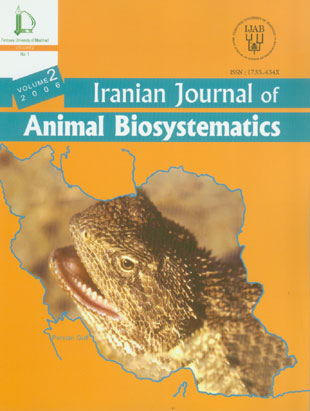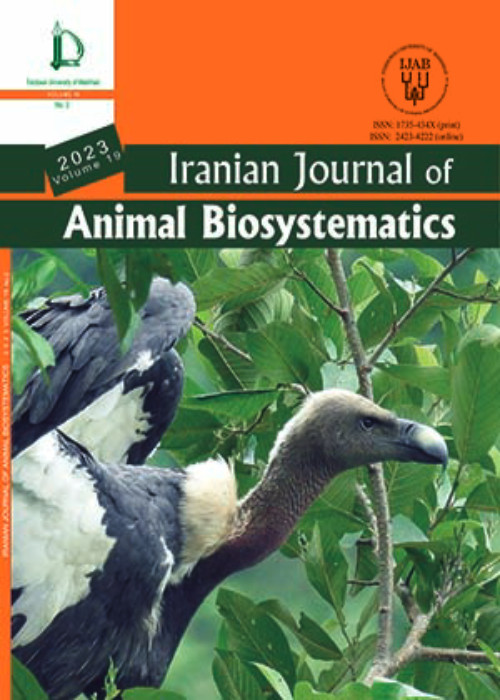فهرست مطالب

Iranian journal of animal biosystematics
Volume:2 Issue: 1, Winter-Spring 2006
- تاریخ انتشار: 1386/10/11
- تعداد عناوین: 9
-
-
Page 1The genus Trachylepis Fitzinger, 1843 encompasses two-three species in Iran: Trachylepis vittata (Olivier, 1804) distributed in western Iran, west of the Zagros Mountains; T.septemtaeniata (Reuss, 1834) in southern regions of the Zagros Mountains and T. aurata transcaucasica Chernov, 1926 from northern to central parts of the Zagros Mountains. For study of geographic variation in the latter two taxa, 58 specimens of these two taxa (T. aurata transcaucasica and T. septemtaeniata) were collected from five distinct localities in the Zagros Mountains and adjacent regions. Post-ANOVA pair- wise analysis (Tukey test) and two multivariate analyses including Principal Component Analysis (PCA) and Discriminant Function Analysis (DFA) based on 22 metric and five meristic characters across all the studied groups verified significant intra- and-interspecific differences in some important characters. Especially, results of the multivariate analyses suggest that most of the studied populations have acquired certain degree of morphological divergence. For instance, 88.9% of west Azerbaijan, 95% of Kurdistan, 90% of Kermanshah, 80% of Lorestan, and 77.8% of Khuzestan populations were assigned to their correct a priori group by classification resulted in discriminant analysis. The specific status of T. septemtaeniata is questioned and it is concluded that this species being just a subspecies of T. aurata.
-
Page 13Myotis capaccinii has only been reported from southern Iran in five localities close to each other within a radius of approximately 100 Kilometers. Five males and two femalescollected from two new localities for this bat are recorded. Among these bats one pregnant female reared in a flight cage for 9 month provided data for postnatal growthand life history characteristics of the species. Various external and cranial measurements obtained from these specimens have been compared with specimens taken from southern Iran and indicate that M.capaccinii reported from western Iran belong to M.capaccinii bureschi.
-
Page 19Barbus sublimus, described by Coad and Najafpour (1997) as a new species, was retrieved first from the Aala Rood, a river in Khuzestan province, southwestern Iran. In our latest sampling a population of this species was found, for the first time, in Fahlian Rood, a river in a different water basin, in Fars province, Southwest of Iran, where no specimen of the species was collected in previous samplings at this location. The detail of taxonomic workdone on the specimens captured, species phylogeny, and the possibilities of its previous absence and then presence are described and discussed.
-
Page 25In this research the glir,s tooth remains from four caves and rockshelter sites in west and north west of Iran have been reported. Recent archaeological surveys andexcavations by Center for Paleolithic Research of National Museum of Iran and two other institutions, along other remains, have yielded rich assemblages of microvertebrate remains. The cave sites are Yafteh, Gar Arjeneh and Qalaloun (Lorestan), and Kani Mikaeil (Kordestan) that have been surveyed or excavated during 2001 to 2005. Except assemblages from Yafteh and Kani Mikaeil which are excavated and collected through systematic dry sieving, two other assemblages are collected fromback dirt of looters pits in those sites. The tooth remains were belong to five families including; 1) Muridae: Meriones sp. Tatera indica, Chionomys cf. nivalis, Microtus socialis,Arvicola terresteris., Ellobius cf. lutescens, Nesokia indica, Cricetulus migratorius, Mesocricetus auratus, Rattus rattus, Mus musculus 2) Calomysidae: Calomyscus bailwardi 3) Dipodidae: Allactaga williamsi, Jaculus sp. 4) Ochotonidae: Ochotona rufescens 5) Leporidae: Lepus sp.This research in based on morphologic and morphometric methods using modern comparative neontological specimens of the osteological collection. Also taphonomic and paleoenviromental aspects in the Zagros are discussed.
-
Page 35Meriones crassus, Meriones persicus, and Meriones libycus from different areas of Khorasan provinces and Yazd province were studied by use of Random Amplified DNA polymorphism (RAPD) technique. DNA samples were analyzed by use of nine primers. Genetic distance among samples varied between 0.24 and 0.78. Dendrogram designed on the base of genetic distance shows separation of these species. In this research, RAPD was used for analyzing the genetic variations among these species.
-
Page 41Ticks are an important problem among zoonotic diseases. Main veterinary species of hard ticks are: Hyalomma sp. Boophilus sp and Rhipicephalus sp. Among them Hyalomma sp. have widespread distribution in Iran and Middle East. The best method to control Hyalomma sp. is immunological one, by using antigens, which causes immunologic and physiologic reactions in host.Bm86 is one of the best antigens, vaccines of which have been produced in Cuba and Australia (TICKGARD, GAVAC).In tracing for Bm86 homologue in H.anatolicum and phylogenic research based on the construction and characterization of this gene. H.anatolicum populations were collected from various regions of Iran and subjected to DNA extraction. After PCR reaction, comparison sequencing of this gene in Hyalomma and Boophilus ticks indicated that probably there are some conserved regions inside this gene in DNAMAN program. More differences between sequences of this gene in H.anatolicum populations collected from Iran and the one from India show that biogeographical separations affect genomic characters.
-
Page 47Many antlions were collected from different regions of Iran, between them, seven species are new records for the locations cited.These species are Acanthaclisis occitanica, Creoleon remanei, Cueta lineosa, Cueta luteola, Myrmecealurus trigrammus, Myrmeleon(Morter)hyalinus, Palpares libelloides.
-
Page 57Samplings were done in different locations of northeastern Iran and different specimenswere collected during two years. The specimens belong to 26 different species attributing to 6 families: Scuridae (Spermophilus fulvus), Cricetidae (Microtus transcaspicus, Microtus paradoxus, Blanfordimys afghanus, Chionomys nivalis, Ellobius talpinus, Ellobius fuscocapillus, Cricetulus migratorius), Calomyscidae (Calomyscus sp. Seems to be C. uratensis), Muridae (Mus musculus, Apodemus witherbyi, Nesokia indica, Rattus norvegicus, Rattus pyctoris, Gerbillus nanus, Meriones libycus, Meriones crassus, Meriones meridianus, Meriones persicus, Tateraindica, Rhombomys opimus), Gliridae (Dryomys nitedula) and Dipodidae (Allactaga elater, Allactaga hotsoni, Jaculus blanfordi, Jaculus thaleri). Standard external characters as well as cranial and dental ones were given.
-
Page 77Recently, some specimens of genus Apodemus were found from Shirkooh Mountains of central plateau of Iran. In order to certify morphologic and morphometric studies, a study has been carried out on the genome of these specimens using random amplified polymorphism DNA (RAPD) marker. Nine random primers were used. The analysis of data determines the separation of Avicenna''s wood mice as a new species. Probably, at the time of ice age, this group of real mouse migrated to central part of Iran. Finally, with the changing weather conditions and appearances of wide deserts around central part of Iran, this group was surrounded there and speciation had occurred.


